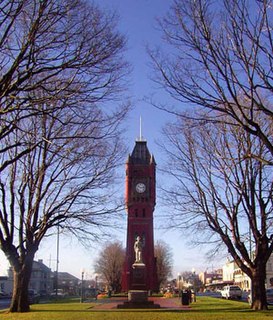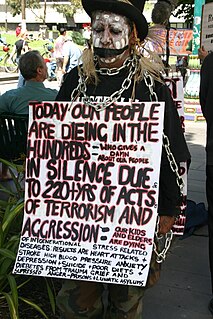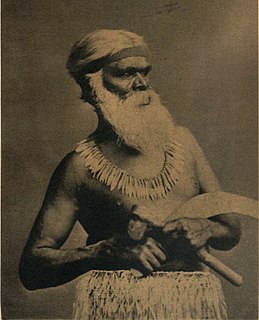
Camperdown is a historically significant rural town in southwestern Victoria, Australia, 190 kilometres (120 mi) west of the state capital, Melbourne. At the 2016 census, Camperdown had a population of 3,369.

Framlingham is a rural township located by the Hopkins River in the Western District of Victoria, Australia, about 20 kilometres (12 mi) north-east of the coastal city of Warrnambool. In the 2016 census, the township had a population of 158.
James Dawson was a prominent champion of Aboriginal interests. He was born at Bonnytoun, Linlithgow, Scotland, the son of a whisky distiller. He arrived in Hobsons Bay, Port Phillip, Australia on 2 May 1840 with his wife Joan Anderson Park, niece of Mungo Park. He tried dairy farming in the Yarra valley for a time but moved to broader pastures in the Port Fairy district in 1844. For the next 22 years Dawson was in partnership in a cattle and sheep station, "Cox's Heifer Station" later named Kangatong, some 10 miles east of Macarthur.
The Dhauwurd Wurrung, also known as the Gunditjmara or Gunditjamara, are an Aboriginal Australian people of southwestern Victoria. They are the traditional owners of the areas now encompassing Warrnambool, Port Fairy, Woolsthorpe and Portland. Their land includes much of the Budj Bim heritage areas.

Djadjawurrung or Dja Dja Wurrung, also known as the Jaara or Jajowrong people and Loddon River tribe, is an Aboriginal Australian people whose traditional lands include the watersheds of the Loddon and Avoca rivers in the Bendigo region of central Victoria, Australia. They are part of the Kulin alliance of Aboriginal Victorian peoples. There are 16 clans, which adhere to a patrilineal system. Like other Kulin peoples, there are two moieties: Bunjil the eagle and Waa the crow.
The Jardwadjali (Yartwatjali), also known as the Jaadwa, are an Aboriginal Australian people of the state of Victoria, whose traditional lands occupy the lands in the upper Wimmera River watershed east to Gariwerd (Grampians) and west to Lake Bringalbert.
The Djab wurrung, also spelt Djabwurrung, Tjapwurrung, Tjap Wurrung, or Djapwarrung, people are Aboriginal Australians whose country is the volcanic plains of central Victoria from the Mount William Range of Gariwerd in the west to the Pyrenees range in the east encompassing the Wimmera River flowing north and the headwaters of the Hopkins River flowing south. The towns of Ararat, Stawell and Hamilton are within their territory. The Djab Wurrung Heritage Protection Embassy is located on a proposed highway duplication on the Western Highway south of Ararat. There were 41 Djab wurrung clans who formed an alliance with the neighbouring Jardwadjali people through intermarriage, shared culture, trade and moiety system before colonisation. Their lands were never ceded.
Murdering Gully, formerly known as Puuroyup to the Djargurd Wurrung people, is the site of an 1839 massacre of 35–40 people of the Tarnbeere Gundidj clan of the Djargurd Wurrung in the Camperdown district of Victoria, Australia. It is a gully on Mount Emu Creek, where a small stream adjoins from Merida Station.

The Gadubanud (Katubanut) also known as the Pallidurgbarran or Yarro waetch, were an Aboriginal Australian people of the state of Victoria. Their territory encompassed the rainforest plateau and rugged coastline of Cape Otway. They are thought to have become extinct quickly following the onset of white colonisation, and little is known of them. Some may have found refuge at the Wesleyan mission station at Birregurra and later the Framlingham mission station, and some people still trace their descent from such a remnant. Today, by the principle of succession, the Gunditjmara are considered the traditional custodians of Gadubanud lands.
The Gulidjan, also known as the Kolakngat, perhaps originally Kolidjon, or Colac tribe are an Aboriginal Australian tribe whose traditional lands cover the Lake Colac region of Victoria, Australia. They occupied the grasslands, woodlands, volcanic plains and lakes region east of Lake Corangamite, west of the Barwon River and north of the Otway Ranges. Their territory bordered the Wathaurong to the north, Djargurd Wurrung to the west, Girai Wurrung to the south-west, and Gadubanud to the south-east.

The Girai wurrung, also spelt Kirrae Wuurong and Kirrae Whurrung, are an Aboriginal Australian people who traditionally occupied the territory between Mount Emu Creek and the Hopkins River up to Mount Hamilton, and the Western Otways from the Gellibrand River to the Hopkins River. The historian Ian D. Clark has reclassified much of the material regarding them in Norman Tindale's compendium under the Djargurd Wurrung, a term reflecting the assumed pre-eminence of one of their clans, the Jacoort/Djargurd.
Kuurn Kopan Noot, or the Warrnambool language, is an extinct Aboriginal Australian language of Victoria (Australia). It had a number of dialects, including Kuurn Kopan Noot proper. Some of these were Dhauwurd wurrung, Gunditjmara, Bigwurrung, Gai Wurrung, Giraiwurrung, Keerray Woorroong, Wirngilgnad dhalinanong, Wulluwurrung. The dialects were spoken by the Gunditjmara, Girai wurrung, Girai wurrung and Djargurd Wurrung peoples.

Aboriginal Victorians, the Aboriginal Australians of Victoria, Australia, occupied the land for tens of thousands of years prior to European settlement. Aboriginal people have lived a semi-nomadic existence of fishing, hunting and gathering, and farming eels in Victoria for at least 40,000 years.
The Bungandidj people are an Aboriginal Australian people from the Mount Gambier region in south-eastern South Australia, and also in western Victoria. Bungandidj was historically frequently rendered as Boandik or Booandik.
The Garrwa people, also spelt Karawa and Garawa, are an Aboriginal Australian people living in the Northern Territory, whose traditional lands extended from east of the McArthur River at Borroloola to Doomadgee and the Nicholson River in Queensland.
The Mutumui were an indigenous Australian people of northern Queensland.
The Walmbaria are an indigenous Australian people of Cape York Peninsula in northern Queensland.
The Bilinarra, also spelt Bilingara and Bilinara, are an Aboriginal Australian people of the Northern Territory.
The Thangkaali (Danggali) are an indigenous Australian people of the state of South Australia.
The Pallanganmiddang, otherwise known as the Waywurru, were an Indigenous Australian people of North-eastern Victoria, in the state of Victoria, Australia. Recent scholarship has suggested that In Norman Tindale's classic study his references to a Djilamatang tribe and their language arguably refer in good part to the Pallanganmiddang